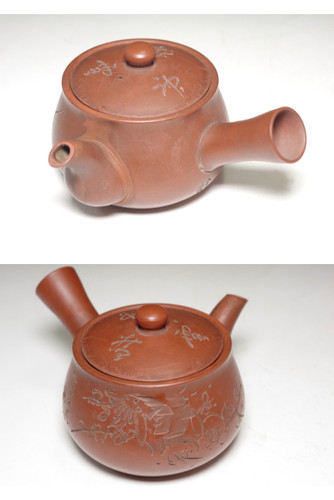Vintage Tokoname pottery teapot #4830
- SKU:
- 4830
- Shipping:
- Free Shipping
- width: approx. 11.7cm (4 39⁄64in) x 10.2cm (4 1⁄64in)
- height: approx. 7cm (2 3⁄4in)
- weight: 150g
Tokoname pottery
The Tokoname kiln has the longest history and had the largest production area among Japan’s six old kilns (Tokoname, Shigaraki, Bizen, Tamba, Echizen, Seto). Its beginning dates back to the late Heian period (approx. 1100 AD), and an estimated 3000 Anagama kilns (tunnel kilns) were built in the hilly areas of the the Chita Peninsula in the Aichi Prefecture, centered at Tokoname City. Tsubo (jars), Kame (wide-mouthed bowls), and Yamajawan (mountain tea bowls) were made using these kilns. Tokoname wares made during the Heian period up to the early Edo period are referred to as “Old Tokoname.”
During the latter part of the Edo period up to the Meiji period, the adoption of China’s Shudei (unglazed reddish brown pottery) and European techniques led to a rapid increase in the production of Tokoname wares. “Tokoname Ware” refers to earthenwares made since ancient times in the Aichi Prefecture, centered at Tokoname. It is still a firm favorite.
In the past, there used to be huge lakes in Aichi, Mie and Gifu prefectures including Tokoname. This lake, called Lake Tokai, was a larger lake than the current Lake Biwa. The production areas of Tokoname ware, Shigaraki ware, and Iga ware were once in this lake.
Originally, Tokoname-ware was famous for its red stoneware, which had excellent performance in the taste of the tea. Tokoname’s vermilion stoneware spread among people who like tea because the taste of tea becomes mild with it.
Tokoname’s vermilion stoneware was started by a person named Sugie Jumon (1827-1897). At first, the stoneware was developed from the desire to make a good teapot like Yixing China on Japanese vermilion mud. For this reason, many of the teapots made by Sugiei were made by imitating Yixing teapots, and of course, Sugie himself understood the goodness of Yixing natural vermilion mud. In Tokoname at that time, the teapots were baked using Tokomame’s natural vermilion mud, and its quality was very high.
Unfortunately, now cheap teapots made from a mixture of red‐ocher rouge and vermilion mud have become mainstream. It looks bright and beautiful in vermilion, but if you want a teapot that improves the taste of tea, like a teapot made of natural vermilion mud, you have to buy expensive items or vintage items.
(Note) “vermillion mud” refers to the soil that changes to vermillion from ocher when oxidized and fired with the singular exception of Mumyoi. The soil of Mumyoi ware is vermilion before oxidized and fired.

















